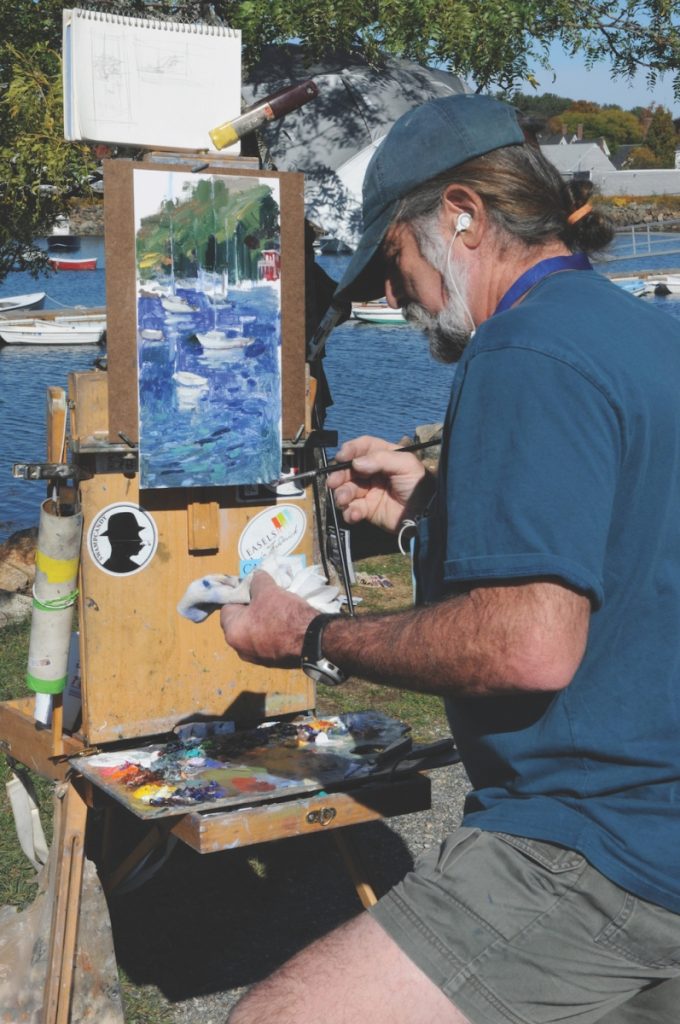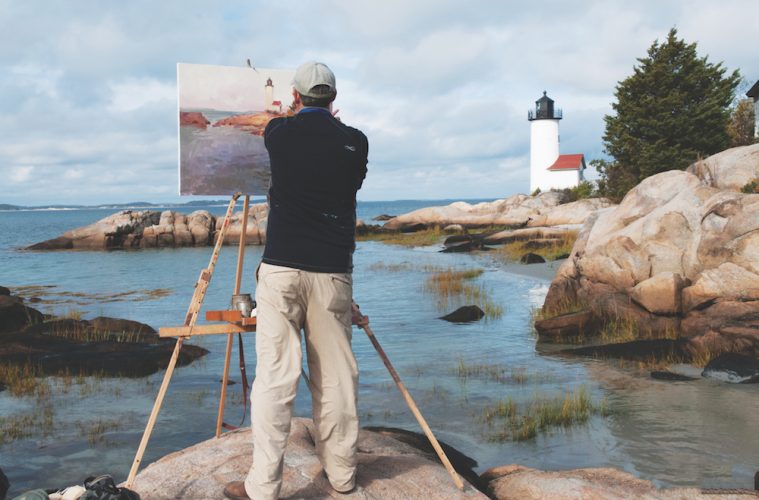On a chilly October morning, as the sun lights the sleepy marsh along the Essex River, a dozen easels sprout from the reeds. Artists lean over their canvases, squinting at their subjects: a wooden dory bobbing in the water, a weathered gray boathouse, whitecaps marching to the sea.
This was Paint Essex, part of last year’s Cape Ann Plein Air (CAPA) festival. This year CAPA takes place October 8 through 16. The weeklong celebration of outdoor painting features renowned artists and live demonstrations across Gloucester, Rockport, Essex, and Manchester-by-the-Sea. And it has quickly become one of the most popular art events in the United States.
“I’ve been to a lot of plein air events across the country, and this is the most memorable,” says Macario Pascual, an award-winning artist who traveled to Cape Ann last year from his home in Hawaii. “There’s so much to paint here—so much color.”
In 2016, 170 painters applied for CAPA’s 40 juried spots, which are chosen by a blind process. In all, 150 artists participated in the first festival, using watercolors, oils, and pastels to capture Cape Ann’s distinctive landscapes. This year, 182 artists applied for a juried spot in the event.
According to organizers, the idea for an outdoor painting festival on Cape Ann began at a holiday gallery event two years ago. What started as a casual conversation quickly grew into a major plein air festival that draws professional painters from across the country.

“To be honest, when we started planning this, we weren’t sure it was going to take off,” says Tony Sapienza, one of the event’s organizers and co-owner of Blue Shutters Beachside Inn in Gloucester. “But when we got that many applicants (in 2016), we realized there was a lot of pent-up interest in Cape Ann.”
Out-of-town artists stay with local residents, and many painters bring their families and immerse themselves in the region’s seaside traditions, shucking their first lobster at Woodman’s of Essex or strolling the shops along Rockport’s Bearskin Neck.
Hundreds of art enthusiasts also flock to CAPA, eager for the chance to stand side by side with renowned painters at work. The celebration features official and impromptu sessions across the region, and passersby can find artists at Gloucester’s Rocky Neck or Eastern Point Lighthouse, or perched atop the cliffs at Rockport’s Halibut Point State Park. In Essex, the public can watch painters in action at the coastal farm at Cogswell’s Grant and near the seaside cottages of Conomo Point.
Last year in Manchester-by-the-Sea, artists propped up their canvases at Tuck’s Point or on Singing Beach. And a Painting-by-the-Sea Quick-Draw challenged artists to complete a two-hour masterpiece in downtown Manchester or overlooking Manchester Harbor. This year the Quick Draw will take place at the Essex Historical Society and Shipbuilding Museum on Sunday October 15.
For Andre Lucero, unspoiled New England seascapes and the region’s rich art history are the centerpieces of the CAPA festival. A professional plein air painter from Virginia, Lucero travels to more than a dozen plein air events each year, producing some 100 outdoor works. He looks for historic landscapes and structures “that have that patina on them,” and he says Cape Ann’s art provenance rivals those of Europe’s top art enclaves.
“In the U.S., we tend to lack old things,” says Lucero, 49. “On Cape Ann, it’s very classic New England. There are so many old roads and harbors and so much old architecture. You can feel the history when you’re out painting these kinds of scenes, and it influences the way we paint.”
For centuries, Cape Ann has drawn artists to its shores to paint en plein air, inspiring some of the most famous alfresco art in the world. In 1873, Winslow Homer spent the summer at Gloucester’s beaches and harbor, where he mastered the medium of watercolor. He returned in 1880 to capture the city’s fishermen in sketches, some of which he turned into oil masterpieces such as Breezing Up.
Other artists who found their muse on Cape Ann include 19th-century master painters Fitz Henry Lane and Mary Blood Mellen and the 20th-century realist Edward Hopper.
But beautiful scenery and artistic tradition are just part of the draw for CAPA’s artists. Like similar events from Maui to Maine, the North Shore festival offers painters a chance to sell their improvised creations to an eager public. Festivalgoers can see and purchase juried works at auctions, galleries, and museums across all four communities. And a Grand Awards Gala and Sale honors the event’s top painters with $20,000 in cash and prizes.
Last year’s artists sold several dozen plein air paintings, according to Sapienza. Pieces ranged in price from a few hundred to a few thousand dollars.
Of course, even in Hawaii or San Diego, planning a weeklong outdoor painting festival can be challenging. In New England, where October can bring nor’easters, hurricanes, and even snow to Cape Ann, pulling off a plein air celebration can be downright daunting. Last year’s event featured sunshine and mild temperatures for the entire week, but what happens when the weather turns stormy?
“These artists are hardy souls,” says Karen Ristuben, CAPA’s project manager. “They carry umbrellas.”
They also know that weather and the changing seasons are integral to New England’s artistic milieu, inspiring not just painters but photographers, philosophers, and authors. From Fitz Henry Lane’s oil masterpiece Ship in Rough Seas to Henry David Thoreau’s Walden and Sebastian Junger’s bestselling book The Perfect Storm, creatives use the region’s fickle winds as a metaphor for the human struggle.
No matter the weather, painters like juried artist Eli Cedrone know that autumn on Cape Ann is always canvas-worthy. For 30 years, the Stoughton resident has painted idyllic settings from California to Italy. While the scenes in her works are disparate, the common element, she says, is that same intangible that makes Cape Ann one of the oldest art colonies in the Western world.
“It’s the light,” says Cedrone. “Especially this time of year, when the sun is lower, it’s amazing light. Most of the places artists go that have a long history of painting, it’s the light that brings them.”
Cape Ann Plein Air

